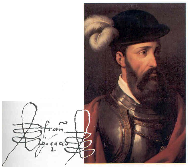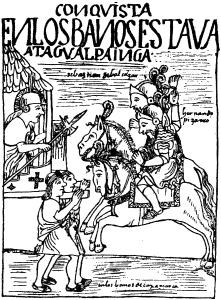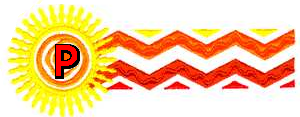

pacarina: See, paqarina, below.
Pacarimoc Runa: (n) Literally, the first men who emerged. Those people did not know how to do anything, not even how to make clothes; they wore tree leaves and straw mats. Nor did they know how to make houses; they lived in caves and under cliffs. GPA
Pacaritambo: (n) Abode of Procreation where Inti gave life to the first mortals, who were created there after the flood (Uñu Pachacuti) and emerged from three caves. NFL (See, Tambo Toco, paqarichiy.)
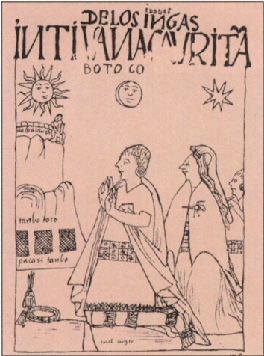
Pacaritambo, drawing by
Felipe Guaman Poma de Ayala.
Felipe Guaman Poma de Ayala.
paccariscas: (n) The places where tribal ancestors were believed to have emerged into the world. These could be caves (the most important one being Pacaritambo), hills, lakes or springs (paqarinas), and they became important centers for thanksgiving.IAWS
pacsi: (n) Month. AEAA
pacha: (n) (1) Location in time and space; where time and space are in conjunction. (2) Life phases; the in-between space, a bardo. (3) The physical world. Time, earth, space, universe. ROR JLH AVO (4) The Divine Cosmos. It includes quantity, other realities, Divinity, what is still a mystery. IGMP (5) Age; era; time. (6) Oneself; a being. (7) Soil; nature; place. RS
pacha callaripaua (AYM): (adv) At the beginning of earth. ASD
Pachacamac, Pachakamak: (n) (1) Literally, he who animates the world. Universal masculine energy in time and space; creator of the world. Deity of the Andes; world ruler; creator; he who puts order in the world. RS A chthonic creator-god, originally worshipped by the Yuncas but then adopted by the Incan Empire. He was a son of Inti and Mama Killa, and husband of Pachamama. WIC When he had created the first man and woman, he forgot to provide them with food. When the man died, the woman accused Pachacamac of neglect, whereupon he made her fertile, and she bore a son. The god killed the son, cut the corpse in pieces from which grew the various fruits and vegetables. The second son escaped him, however, and so the god slew the mother. This son, called Wichama, avenged his mother's death by driving Pachacamac into the sea. WPO Primarily he was the Underworld god causing earthquakes but may have been related also to the fertility of the Earth. His wife, Urpihuachac, had thrown the first fishes into the Ocean. PRM Some scholars say this is an attribute of Wiracocha. HOI Pachacamac appears to have been a Chimu deity. As a child of the sun and the moon, he was a brother to Con. The cult of Pachacamac survived the might of Inca domination. IAWS He who animates the Worldprimarily was the Underworld god causing earthquakes but may have been related also to the fertility of the Earth. Once [pre-Conquest] included characteristics of Tricksters. RTZ1 A supreme god who was worshipped at a large adobe pyramid (of the same name) to the south of Lima on the coast of modern Peru; a god with two sides, one male and one female, represented by a large, carved wooden pillar that was destroyed by the Spanish. ANON1 (2) A temple outside of Lima where the philosophy of yanantin was born. RS NND The site of Pachacamac on the central coast of Peru has long been regarded as the preeminent religious and/or pilgrimage center of pre-Hispanic Peru. The fame and power of its oracle and ancient temples, together with myths pertaining to its dualistic, earth-dwelling, patron deity named Pachacamac, have been described by both Spanish Colonial writers and modern scholars. This deity is said to have had the power, on the one hand, to create and sustain humans, nurture crops, and cure disease, and, on the other hand, to cause earthquakes, storms in the Pacific, and disease. In his 1534 report, Miguel Estete, for example, noted that many pilgrims from far and wide came there to pay respects, consult, and/or make offerings to the oracle at the Temple. This sanctuary was surrounded by shelters for pilgrims and the tombs of noblemen and priests, who wished to be buried close to the deity they had worshipped. WPAP After crossing inhospitable mountains, travelers would be awed by the temple. Fantastic murals covered the adobe walls and through its many doors access could be found to a series of plazas. Pachacamac not only offered advise to individuals, but offered protection from natural disasters and disease. In return, he expected tribute in the form of goods and the blood of sacrificial victims, both animal and human. IAWS
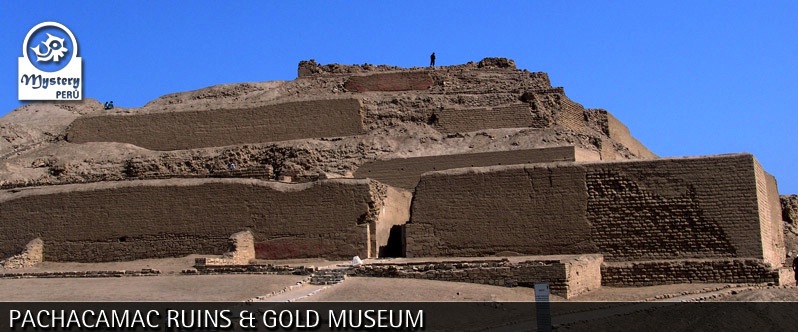
The temple at Pachacamac. The entire site is complex and extensive, an estimated 5 km2.
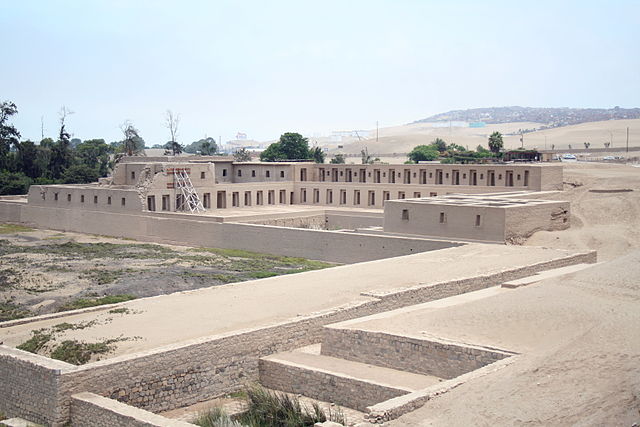
The original pre-Inca ancient temple faced the northwest side of the coast, had terraced sides
and richly decorated rooms, possibly destined to the reception of envoys and to the ritual making
of sacrifices. Before reaching its shrine, pilgrims, priests and noblemen alike were compelled to
fast for twenty days before to gain access to the first court on the lower plaza, and for an entire
year before ascending to the holy of holies, the holier shrine on the upper plaza, of exceptional
sacredness and immense religious significance. WIKI
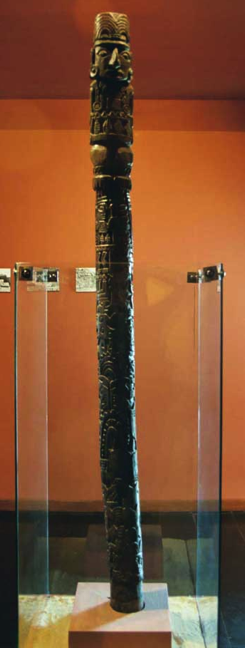
Above the inner shrine stood a pyramid at the top of which was the wooden idol of Pachacámac. Only the priests could have access to the oracular chamber, consulting the oracle on special important issues – on behalf of others – but were themselves forbidden to look directly at the Janus-like idol, from the sight of which they were protected by a textile that hung before it, in function of screen. The wooden Idol reflects the cosmogonic vision of the Andean people of the 12th century. Two-faced, possibly hinting at an androgynous nature, the oracular powers of the god are evident in the possibility of seeing simultaneously – spatially and temporally – in opposite directions. EMM
pachacuc: (n) A pachacuc would perform a health divination by placing a large spider on a wide ceramic bowl or on top of a large woolen mantle. Then he would mutilate the animal with a stick, aiming to crush one of its legs. The spider was then observed by the diviner who deduced, from the location and extent of the damage, the answers he was to give. DYE
pacha cuti (AYM): (adj) Of war. ASD
pachacuti, pachakuti: (n) (1) A cataclysmic event separating eras in time. The founding of the Inca Empire was seen as the beginning of a new era, and the Inca ruler responsible took Pachacuti as his name. The Conquest was also seen as a pachacuti, in the sense of a great disaster. Felipe Guaman Poma de Ayala mourned it as a world in reverse because hanan and hurin had been overturned and the Spanish had failed to institute a new order that was just or made sense. CSCR (2) Coming back to source. TP A return to the essence of the cosmos. There is a cosmic cycle of one thousand years, like the cycle of day and night. Five hundred years is daytime, five hundred is nighttime. The Spanish arrived with the sunset between 1492 and 1532. Now we are living in a New Sunrise, which is very special because this first light is food for the heart. IGMP The revolution of time and space, the concept of succession and renewal. The Incas believed in an elaborate succession of worlds or creations, inhabited by different races of beings and/or civilizations. Each age was referred to as being ruled over by a Sun [and assigned a successive number]. The general course of development was from the more primitive to the sophisticated. Each world ended, destroyed by some catastrophic event. MAN (3) A period of upheaval and cosmic transformation, overturning of the space/time continuum that affects consciousness. Reversal of the world. KOAK ROR A cosmic transformation or world reversal in the form of a critical mass experience in the complexity of consciousness (specifically human) that ultimately brings about a new, distinct, more encompassing paradigm of one's relation to the self and the living universe. Named after the second founder of the Inca empire [see, Pachacuti Inca Yupanqui, below] who completely remade the entire social fabric of Cusco during his reign. The word itself may stem from the words pachak and kuti, which, when placed together, mean centuple, or a hundred times as great.PSPM An Inka notion of a shift in spiritual, magnetic, and energetic currents of the Earth brought about by a critical mass or matrix of high-vibration transformed and transformational consciousness (usually human), causing massive upheavals and cosmic changes in both the activities and consciousness-reality paradigm of humanity and leading to a distinct, more “whole” or all-encompassing world and world-view. ANON1 (See, First Sun, Second Sun, Third Sun, Fourth Sun, Fifth Sun.)
Pachacuti Inca Yupanqui, Pachakuteq Inca Yupanqui: The ninth Inca emperor whose remarkable rule (1438-1471) earned him the appellation Transformer of the World and Earthshaker. Among his accomplishments he rebuilt Cusco after it was destroyed in the war with the Chanca (see, Appendix M), he built Machu Picchu, developed the state and organized the institutions and systems that would become the hallmarks of Inca rule: national taxation and labor levies, roadways and imperial communication network, and extensive warehousing of food and other commodities for redistribution throughout the empire. MAN (See, Appendix H.)
“I was born as a lily in the garden and thus I was raised. And I grew and got old
and died out and I passed away…” … and after saying these words,
Pachacutec reclined his head and expired … -- Sarmiento de Gamboa, 1572. DYE
and died out and I passed away…” … and after saying these words,
Pachacutec reclined his head and expired … -- Sarmiento de Gamboa, 1572. DYE
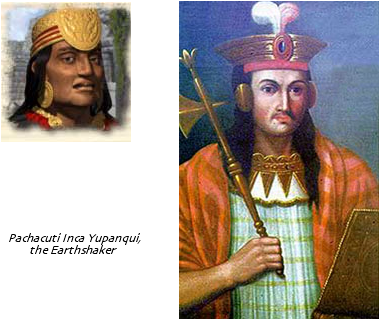
Pachakúti Mesa: (n) A synthesis of Peruvian shamanic wisdom teachings, which focus on the experiential use of a consecrated healing altar [as taught by Oscar Miro-Quesada]. A syncretic blend of the huachuma curanderismo of the north coast and the Andean paq'okuna traditions of Peru. PSPM
pacha kuyuy: (n) Earthquake. QP
pachakamanta: (n) The large ornament at the start of the quipu has as its archaic name pachakamanta. It means from a hundred or concerning a hundred, which would indicate a relation to the Inca concept of the hundred as a standardized political unit. Ayllu Segunda Satafasca owns this example. It is decorated with a Turk's head knot of parallel metal-wound threads. Metal-wound thread is a design of European origin, but the manufacture appears local. AWE See, Appendix C, for more on quipus.

When the ayllus present their respective quipocamayos to the
entire village, they twist the quipocamayo with all its pendants into a
single large cable, and tie it into one huge knot. The large ornament
marking the start of the record should point upward.
Pachamama, Pacha Mama: (n) (1) Mother Earth, Gaia; both the physical planet and the goddess archetype. Universal feminine energy in time and space; cosmic mother. Wife of Pachacamac. WMO Goddess of the earth and overseer of planting and harvesting. seen as a huge dragon which causes earthquakes. GM The Earth Mother of the Chincha of Peru. The supreme god Pachacamac emerged from her. She is also mentioned as his consort. WPO Goddess responsible for the well-being of plants and animals. Offerings to her of coca, chicha and prayers are made on all agricultural occasions. MANThey Inca propitiated Pachamama, and other spirits, by placing offerings on mountaintops, in crevices and caves, and buried near buildings or fields. One kind of offering used throughout the Inca realm involved copper, silver, or gold figurines dressed in elaborate miniature garments, often decorated with feathers. BOC She predominates in agriculture and may have a position similar to Roal, since her powers are not subject to him nor have they been delegated by him as in the case of the great apus. She may well be, rather, a being of pan-earthly powers who intervenes as the feminine factor in the origin of things. JNP The Wamanis are associated with the mountains, the highland pastures, the sky, livestock and man. Pachamama is associated with the earth, agriculture and woman. Thus there is an opposition between these two divinities. But they are related to each other through the mediation of the Amaru, who inhabits the springs and lagoons of the high pastures. From there he circulates to the valleys through streams and irrigation canals, for his principal element is water. Ritual offerings are deposited in the springs found at the foot of the mountains in the high country. Then the Amaru emerges from the Ukhu Pacha to sweep the gifts of man down to the valleys below. In this fashion the Wamanis (sky) communicate with Pachamama (earth) through the mediation of the Amaru (water). WOFW(2) Physical body/matter permeated by the etheric and vital stress systems, which hold the world together. PSPM (Also, Mama Pacha. See, mama.)
The Pachamama is the point where time and space meet. The past, the present and the
future are born from her and all return to her. She is the universal and eternal matrix.
The apus, the ancestors, and the various spirits are all born from her, controlled by her,
and protected by her. . . . Man, too, with his family and all his possessions . . . is born
from her, nurtured and raised by her, and finally drawn back within her when he dies. GSC
future are born from her and all return to her. She is the universal and eternal matrix.
The apus, the ancestors, and the various spirits are all born from her, controlled by her,
and protected by her. . . . Man, too, with his family and all his possessions . . . is born
from her, nurtured and raised by her, and finally drawn back within her when he dies. GSC
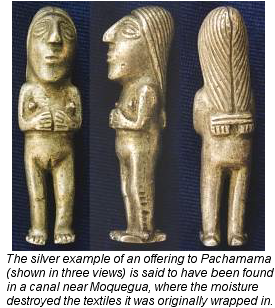
Pachamamakamak: (n) Mother Earth as the relationship of time and space, above and below.
pachaq quipu: (n) One of the meanings of pachaq is of the earth or worldly. (See, pacha.) Pachaq quipu was used in context as different from qhapaq quipu, which are royal quipu. See, Appendix C for more on this and to understand more of the context. PGO ANON1
Pachatira, Pachatierra: (n) (1) Refers to a concept of earthly or subterranean fecundity, which is important in a discussion of celestial animals (def. 2) which originate from and are actually composed of the earth. We find in the Andes a general belief in the subterranean origin of all animals. ACES (2) Dark cloud constellations which are located in that part of the Milky Way (Mayu) where one sees the densest clustering of stars and the greatest surface brightness, thus the fixed clouds of interstellar dust [dark matter (Yana Phuyu)] have the greatest contrast. They represent a transitional, intermediate category of celestial phenomena; even though located in the sky, they are classified as pachatierra, or pachatira, the Spanish and Quechua words for earth. There is a correlation of the astronomical periodicities of the pachatira with the biological cycles of their animal counterparts on the earth (sp). ACES (See, yana phuyu for a fuller explanation.)
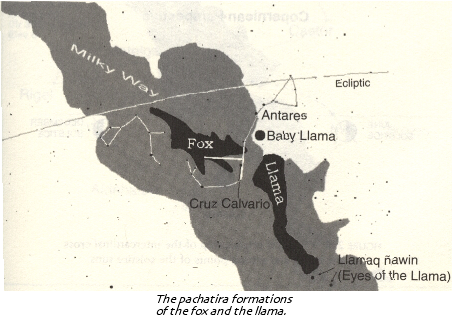
Pachatusan: (n) (1) The name of one of one of the sacred mountains of the Inca empire. Its mystical significance is as the nexus, the axis of ceke lines, of power in the mesa which is known as pachatusan. (2) The axis to which you anchor your engagements, your ability to assemble your reality and not collude with ordinary reality (which is reaction). JLH
pacha yachachiq: (n) Literally, world teacher. Refers to one who intervenes on Earth as a direct manifestation of Creator, divinity, and cosmic consciousness, such as Christ, Thunapa [and Gautama Siddartha]. ANON1
pago (Span): (n) (1) A despacho offered in payment or atonement, often given with food and drink. KOAK (2) Payment. GOL
pago a la tierra (Span): Literally, payment to the earth. Alcohol, burnt offerings and smashed pottery to ensure fertility of the fields. JAR
pahuata-huinac, hacchiques: (n) Monnina salicifolia. Pahuata-huinac means growing at night. Women prepare from this plant a hair wash and believe that it stimulates exuberant growth of the hair. The saponaceous constituents free the scalp from dandruff and the hair from oils. The roots are very bitter and have a much higher saponine content than the rest of the plant. Excellent medicinal virtues, especially for treating dysenteries, reside in these roots. REPC
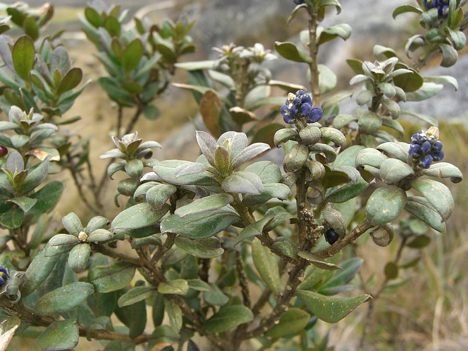
Pahuata-huinac. WIKI
paico, payco: (n) (Dysphania ambrosioides, formerly Chenopodium ambrosioides.) Also called epazote, wormseed, Jesuit's tea, Mexican tea, or herba Sancti Mariæ. The most common medicinal use of the leaf is antihelmintic (destructive to worms) and antiparasitic. Paico leaf is also considered effective in treating skin and kidney diseases, stomach aches, hemorrhoids, high blood pressure, inflammations, and asthma. Recent studies show it to be effective against many different cancerous tumor cells. In homes, people hang branches in the house to repel insects and use the leaf to season soups. AHC Paico is commonly believed to prevent flatulence caused by eating beans and is therefore used to season them. It is also used in the treatment of amenorrhea, dysmenorrhea, malaria, chorea, hysteria, catarrh and asthma. WIKIShould not be used while pregnant or nursing. Has traditionally been used to induce abortions. Do not take while trying to conceive. WAHC It is the best naturally occurring vermifuge and until very recently it constituted the basis for many compound remedies. DYE
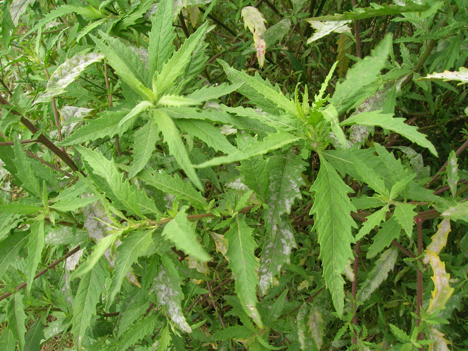
Paico.
Paititi: See, Paytiti.
pakasqa: (adj) Hidden. PSL
palero (Span): (n) A vegetalista who uses entheogenics from the bark of various trees such as ayahúman (Couroupita guianensis), huacapú (Minquartia guinensis), clavohuasca (Tynanthas panurensis), chuchuwasha (Heisteria pallida), ch'ullanchaki-caspi (Tovomita sp., Guttiferae), remocaspi (Aspidosperma excelsum Benth.), lupuna colorada (Cavanillesia hylogeiton), et al. AYV
palo santo (Span): Literally, holy stick. A type of incense used in curanderismo for purification and to bring in refined energies; incense used to counteract daño in the form of mal aire. PSPM
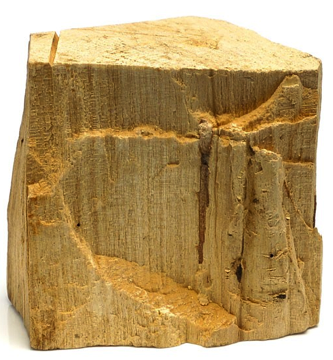
A block of palo santo.
pambamuri (Amaz): (n) A mythological huge, hairy ray fish, also known as rayamama, sometimes 30-40 meters wide. Whirlwinds ride atop it and it is connected with soul imprisonment. It sinks boats, erodes riverbanks and acts as a lid for a network of subterranean tunnels which connect cities at the bottom of lakes and rivers. AYV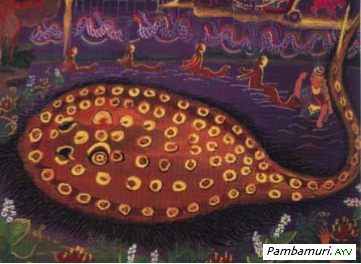
pampa, bamba: (n) (1) Land, ground, valley. RS Plain or flat area of any size. CSCR (2) Understanding and dialogue with elementals and nature. (See, pampamesayoq.) (adj) Flat. CSCR
Pampachaway!: (expression) Excuse me! Sorry! RS
pampachay: (v) To forgive, to pardon; literally, to make level . PSL RS
pampalla-soncco: (adj) Inattentive; scattered of mind. DYE
pampamesayoq: (n) Shamanic level of caretaker of the land, cycles of the natural world; keeper of the earth. AVO Lower shaman; Andean priest of the second level who specializes in rituals like performing despachos or coca leaf readings. RSAn inferior [to the altomesayoc] shaman of the Andes who has been struck by lightning only once. The pampamesayoq can practice both black magic and divination, as well as cure and combat black magic. The pampamesayoq is guided by the Koa. The Koa selects the shaman and gives him power by striking him with lightning. WOFW The one of the low tableis like a general medical practitioner treating all types of physical and mental ailments, performing cleansing rituals to eliminate bad spirits, divining with coca leaves, and conducting ceremonies to honor Pachamama (see, above), the Awkisand Apus. ACAI
pampa warmi: (1) A prostitute; (2) an adulteress. RS
pampayruna: (n) A female prostitute. They were located in the outskirts of the populated centers. DYE
panaca, panaka: (n) The original ten or so royal ayllus of the Inca imperial household; direct descendants of the first ten kings of Cusco. The panacas complemented the original ten ayllus of the tambos at Tambo Toco. MAN In Inca times this word refers to the twelve royal lineages of Inca families that competed in the Wiracocha Temple to become the next Sapa Inca or ruler of the Empire. QNO RS Family group. DYE Sometimes used generically as a word for mystical lineages. ANON1(See, Appendix H.)
pancunco: (n) A ritual game played after the Situa ceremony. DYE
Each individual armed himself with a large bunch of ichu and, tying it to the end of a cord, he would set fire to it. Swinging it over his head, each attempted to persecute those near him smashing the flimsy fireball on body or limb. It is apparent that, except for a few superficial burns, no real damage was done or reported. The game, according to the description, was carried on with an ample display of humor and gaiety, and each attempt to strike somebody with the burning ichu was accompanied by shouts of “out, out with disease!” DYE
panga-cometas: (n) Comets of living leaves which change into flying animals that assist the vegetalista (sp). AYV
pani: See, paña, below.
panque, panke: (n) Gunnera tinctoria. The mucilage from the tender stems and fresh shoots is applied to the kidneys to lower the temperature of the blood in severe fevers. The decoction and powder of the root are believed to be good astringents and have various therapeutic uses. REPC
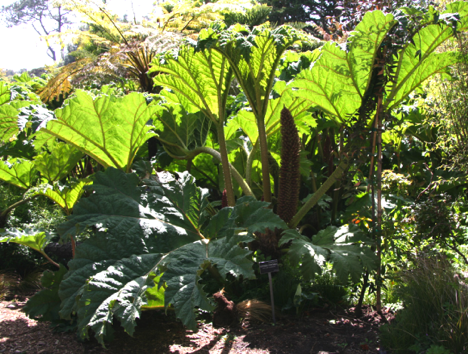
Panque.
panshin oni (Panoan): One of three kinds of ayahuasca distinguished by the Shipibo according to color, yellow ayahuasca, from vines having three different mamas: the boa, the grasshopper and the chicua bird, which with its song announces whether the vegetalista should cut the vine at that time. AYV Yellow ayahuasca, traditionally considered the best for initiation. The most commonly employed in curanderismo in Amazonian Peru. WSEC (See, oni.)

Panshin oni.
panta: (adj) Wrong, mistaken. QP
pantacak: (adj) Mentally perturbed. DYE
pantay: (v) To make an error. QP
pantayta-uyarini: (adj) Hard of hearing. DYE
panteon: (n) Cemetery (sp.). PSL
paña: (n) (1) Female friend of a male, sister of a man. QP ICC (2) Right hand; right side. QNO (3) By balancing your own llokeand paña energies, and following the pathway of your power, you can go through any obstacle, even physical walls. IGMPRight hand side of the path, relating to mystical knowledge; the cold, rational, objective and structured side of the path governing initiation and ritual; known as "the road to god." The side of the path where the shaman communicates directly with spirits. Lloke and paña must be integrated to fully push the kawsay. JLH That which is correct and in alignment with good. PSPM The road to God, focusing on mystical knowledge and the rational, objective and structured side of the path governing initiation and ritual. ANON1 (3) Feminine equivalent of wayqi. JLH (See, authentic self.)
papas-trueno: (n) (Dioscorea sp.) is a kind of yam. The person who consumes this plant is able to summon the rain or keep it from falling, to control the wind and thunderbolt. It is very difficult to obtain, found in high hills in the jungle. It looks like a golden heart. AYV
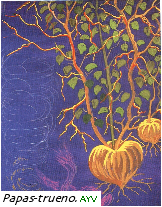
paqar: (adv) Very early in the morning. TLD
paqaricu, pacaricu: (n) The rites of death, which lasted five days and consisted of the preparation of the body for burial, many magic and religious rites, and ample indulgence in food and alcoholic beverages in an atmosphere of mournful music and wailing. The cult of the dead in Peru was raised to heights never attained by any other culture of the world. In some regions and cultures artificial mummification was performed or were evidently the product of natural dehydration produced by the dryness of the desert sands, or the coldness of the mountain caves, or the limitations of putrefaction by the airtight wrappings with which the cadaver was protected. The cadaver was then subjected to a careful process with different substances, mainly of vegetable origin. Of these secret procedures very little is known. The bodies of the Incaelite were carefully prepared to avoid corruption; they were eviscerated and the heart was kept in some holy place separate from the rest of the body. Garcilaso tells us that the heart and main viscerae of the Incas were kept in the Temple of Tampu (Ollantaytambo). Cobo says that they were kept inside a human form representing the sun god. The statue was made of gold, except for the hollow abdomen “which was filled with a paste made of gold dust and mixed with the ashes of the hearts of all the Incas.” DYE [It is interesting that the word for the death rites has the same root (paqa) as is in the words for emergence, birth, dawn, etc. This gives more perspective on the cult of the dead (see). -- Patt]
paqarimuy: (v) To be born. RS
paqarina, pacarina: (n) (1) After the Uñu Pachacuti, Wiracocha made the different peoples out of clay and then painted on the garments that each group was to wear. Each was given its own language, songs, and favorite foods and even hairstyle. Then he sent them to the various regions to which he had assigned them -- the lakes, caves and mountains from which they re-emerged into the light. IAWS Communication between the surface of the earth and the Ukhupacha was achieved through the paqarinas -- caves, volcanic craters, springs and lagoons. WOFW A paqarina is an opening in space/time believed to be an entry and exit point between worlds. PSPM Their dual interpretation of the world found the concept of the paqarina as an answer to the riddle [of physical causes vs. psychosomatic illness]. Man was not permitted to leave his original milieu because he was bound to a life within the reign of his own regional gods; the mountain, the lake, the river, the ocean, the jungle, the plateau. And if he went away, he committed a grave sin. A sin against his own god; and, just as important, a sin against the rules of the Empire. [See, climatology, for more on this.] DYE Places of emergence such as caves, water, mythical beings. Good sources for inspiration and creative energy. JLH Place of origin or dawning. Most ancient and many modern Andean ethnic groups and ayllus consider a particular rock, cave, spring, mountain, or other natural feature as their paqarina. CSCR Portal to the kingdoms of creation. RMFA Compare, nierika and torus. (2) Female nature spirit who is the guardian of one's birthplace; most prominent feminine aspect of the natural geography at one's birth site. JLH QNO (3) Female counterpart of the Itu Apu. RS QNO (See, Susurpuquio, for an image.)
paqariy: (v) To be born, appear from, originate. TLD
paqcha: (n) A carved and painted staff-like device with a bowl on one end, used in divination ceremonies by Inca priests. MAN
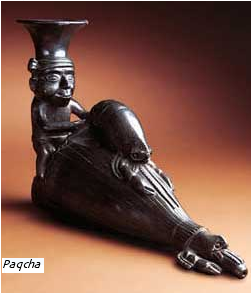
paqocha: (n) A cross between an alpaca and a llama. TLD See, paq'o, def. 2.
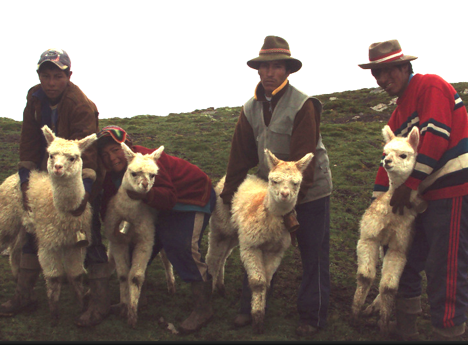
Paqochakuna with herders.
paq'o: (n) (1) Healer, shaman in the Andean tradition who treats soul illness. By returning balance between the body and spirit through complex rituals, plant and animal medicines, and healing stones, paq'os treat the cause of illness rather than alleviating only its physical symptoms. ACAI (The paq'o tradition is itself divided into three levels: pampamesayoq(see, above), altomesayoq and kurak akulliq.) (2) A white llama or alpaca, a confusion of the Spanish who thought that was the Quechua word for the animal. These white animals talked and gave prophecies, which is why they were called paq'os. JLH
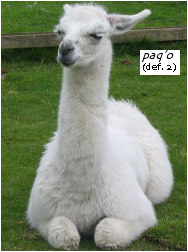
paq'okuna, paqokuna: (n) Medicine people. JLH The shamanic practitioners of hampiq of the Southern Andes. PSPM A generic title for the Andean shaman, regardless of power and specialty. A white magician. WOFW (see, pampamesayoq, above), altomesayoq and kurak akulliq.) (See, also, paq'o above.)
paq'o wachu: (n) (1) A sacred pilgrimage in the form of a vision quest. A path of payment. PSPM Literally, the awakening of the spiritual seed in a shaman initiate. PGO The tradition of vision quest; communion with and the received spirit medicine of the Apukuna. ANON1 (2) Also used to refer to those who observe this practice or carry the lineage. ANON1
paq'o wachu chaka apacheta: (n) An apacheta built in honoring of a pilgrimage site, usually with despacho fire-pit nearby. ANON1
para: (n) Rain. QP The conscious being that is sacred rain. ANON1
Paracas: (n) A culture on the south coast of Peru, one of the first to develop mummification and, probably, ancestor worship, which influenced all later West coastal and Andean cultures. MAN (See, mallqui.)
Paratia: A community in the mountains outside Puno. Historically very inaccessible, over the centuries it has received little impact from outside influences. The inhabitants are considered to have the purest lineage of the Inca textiles. IGMP
Pariti: (n) In August 2004, a Finnish-Bolivian research team working on the island of Pariti in Lake Titicaca made one of the most significant discoveries in recent years of Bolivian archaeology. In two features dug and filled in by the Tiwanakupeople around A.D. 1000, the team recovered the sherds of over 400 smashed ceramic vessels. AMZ Until recently, one of Bolivia's newest archeological finds was stored in a suburban house in a La Paz subdivision. Every available surface in the house was covered with ceramics: a foot embellished with skulls; a vessel depicting a nobleman with a turban-shaped headdress, a wad of coca leaves stuffed in his cheek; two identical vessels in the form of a wrinkled old man holding a duck, a spout projecting from his back. There were vivid images of pumas, monkeys, condors, and fanciful hybrids thereof, man-eating creatures dancing and undulating, grinning and grimacing. Though these stunning pieces are at least a thousand years old, the cracks they bear are not a result of the ravages of time. These vessels were “assassinated.” At least that is the theory posited by the team of archeologists that excavated the objects on Pariti island last year. The archeologists believe that sometime between 900 and 1050 A.D. the ceramics were deliberately broken and deposited in a pit on the island, along with the bones of sacrificed llamas, in a religious ritual — hence the term cerámica asesinada, or killed ceramics. The group's thesis is that the vessels were buried as a ritual offering to the sacred lake. While this thesis is not universally shared, many archeologists agree that the surprising iconography and styles of these objects should provide new insights into the culture and society of Tiwanaku. WANC See, scarification for a photo of one of the pieces.

Isla Pariti is located just off the Bolivian shore in the southeastern
section of Lake Titicaca as seen in this satellite photo. The major
part of the lake is to the northwest and not shown in this photo.
See, map at Appendix B.
section of Lake Titicaca as seen in this satellite photo. The major
part of the lake is to the northwest and not shown in this photo.
See, map at Appendix B.
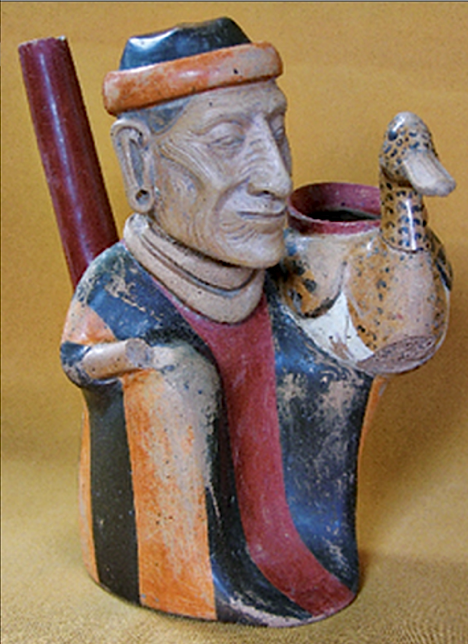
A man of Tiwanako, a ceramic piece found at Pariti.
Note the orejón hole in the ear lobe.
Note the orejón hole in the ear lobe.
Pariacaca, Pariya Qaqa: (n) Literally, igneous rock. MOC (1) An ancient pre-Inca god of water, rain and storms, as well as a god of creation. A five-fold being, he was born as a falcon, but assumed a human form later. He was worshipped in the Central Andes and defeated Huallallo Carhuincho. WPO (2) The mountain of the same name which is the embodiment of the god.
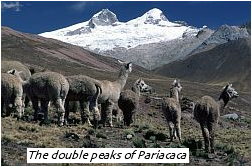
parqui, palqui: (n) Cestrum parqui. Chilean natives employ a decoction or infusion in treating intermittent fevers; an infusion of the inner bark is trunk in fast periods to cure stomach ills. REPC Contains many alkaloids. All parts of the plant are poisonous; the leaves, bark and wood are psychoactive; it has been used widely in practical medicine. PDB The plant is also known to be toxic to livestock and humans. Death is usually rapid and painful. WIKI
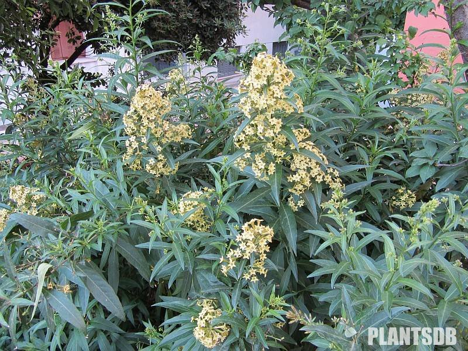
Parqui. PDB
pastilla: (n) (Span) Pill. QP
pata: (n) (1) Place. (2) Upper part. A high place or higher zone, elevation-wise. ANON1 (adv) (1) Above. On top of. (2) Because of. TLD
Patá: (n) A constellation we know as the Belt of Orion, also known as the Three Marys. Mochica, Lambayeque and Chimu cultures show this constellation in their pottery, depicting a central figure of a man whose arms are held by other two persons, usually women. These three stars were considered by the Chimu to represent a thief being led by two envoys of the Moon who must throw the prisoner to the carrion birds, that group of stars immediately below. The representation of this constellation was a very popular subject as a funereal offering [see lower picture below]. DYE
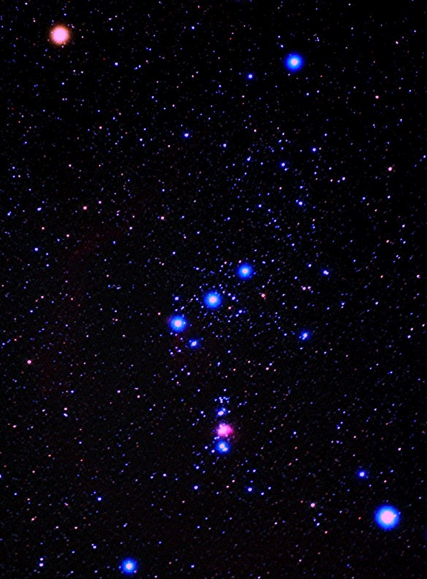
The constellation of Patá.
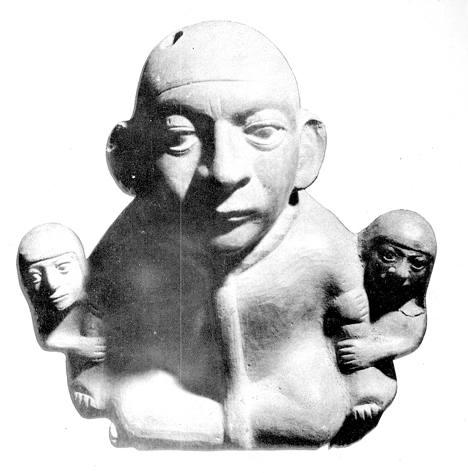
Northern Peruvian ceramics frequently show this group of three persons which probably
represents the constellation of Patá. This piece is Mochica. DYE
represents the constellation of Patá. This piece is Mochica. DYE
pata pata: (1) A terrace formed of earth, bordered by stones, that kept agriculture from eroding the mountainsides. The most important crop of the pata pata was the potato. (2) Stairs, staircase. TLD
.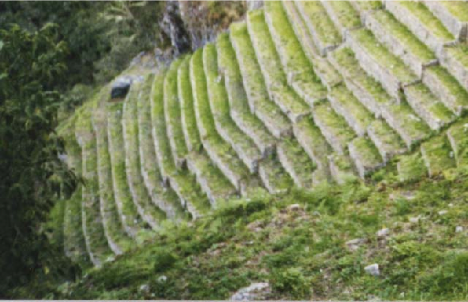

A mountainside with pata patas.
Paullu Inca: (1518-1549) The second Manco Capac's younger half-brother who greatly supported him during the first turbulent months of his rule as puppet-Inca in Cusco. However, when Manco Capac was in rebellion, Paullu sided with the Spanish and seized his opportunity to become puppet-Inca in Cusco. He then embraced the Spanish lifestyle enthusiastically. He wore Spanish clothes, received instruction in the Catholic religion and was baptized Don Melchor Carlos Inca. With the zeal of a fresh convert, he betrayed the location of some of the mummies of his forefathers. HDP An Inca who ruled the empire under Spanish direction. AEAA (See, mallqui and Appendix H.)
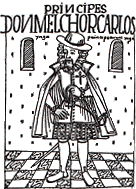
pawi: (n) Darkness, confusion. PSL
pawikuy: (v) To be confused. PSL
payan: (n) (1) Secondary ceke from energy stored in an energy center; the community level manifestation of the ceke line. (2) A term for categorizing the importance of things, in this case medium. (See, huaca, kollana, kayao and Appendix F.) JLH
Paytiti, Paititi: (n) A mythical jungle city where Inkari lives until he can return to unite the Tawantinsuyu. The masculine counterpart of Miscayani. KOAK The Mythical City of Gold or El Dorado spoken of in many historical writings on the Incas. The Spanish were searching to plunder El Dorado, but more than likely misunderstood the spiritual significance of gold to the Inca. RS
penance (Eng): (n) Atonement for misdeeds. Penances were apt to be severe. They almost always involved fasting, which in Inca terms did not mean going without food altogether but merely without meat and seasonings. A more peculiar penance involved being beaten with nettles by hunchbacks who had been specially employed for this purpose. IAWS
perfumero (Span): A vegetalista who employs different fragrances to use in healing. AYV A vegetalista who has learned the way of the plants by dieting with a perfume extracted from several varieties of teacher plants. EMM
perla (Span): (n) Literally, pearl. Two flat seashells reserved for use by the alzadores which are used to hold a liquid mixture to be snuffed into the nostrils prior to performing levantar la mesa. WOFW
personal power (Eng): (n) The process by which the nagual props up the tonal. One of the balancing acts of the warrior is to make the nagual emerge in order to prop up the tonal, allowing the latter to be the protected overseer. TOP (See, luminous warrior.)
peumo: (n) Cryptocarya alba. The Chileans assert that the fruits possess virtues valuable in treating dropsy [an old term for edema (swelling) -- Patt]. REPC
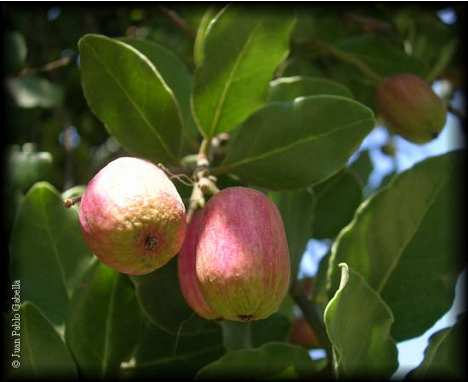
Fruit of peumo.
phosphene (Eng): A phenomenon characterized by the experience of seeing light without light actually entering the eye. WIKI
picchu, piqchu: (n) (1) Pyramid. TLD (2) The cud produced by chewing coca (this cud is often shaped into a small pyramid and given as an offering). ANON1
pichay: (v) To sweep; to clean; to erase. RS
pichi-pichi, pichi: (n) Fabiana imbricata. Pichi-pichi is held sacred for its powers as an incense, as the plant produces a large quantity of fragrant smoke when burned. In Chile, and many other South American countries, the fresh or dried herbage is burned during most all traditional ceremonies, festivals, offerings to nature deities, and so forth. Many native peoples keep bundles of the branches to light as incense whenever purification, cleansing, or an energy shift is needed. When an individual is ill, the sick room is filled with the smoke of pichi-pichi, which is said to banish unwanted spirits and demons, and to push away the darkness of sickness. In the Atacama Desert, this incense is burned to purify spaces, and to calm and liberate the spirits of the dead. ELC This plant is believed to possess wondrous antihelmintic properties for curing sheep and goats of an ailment (pirguín) that wipes out whole flocks. This is why farmers take affected animals to pastures where pichi-pichi abounds. With this fodder, the animals recover and fatten up in a few days. REPC In the Atacama Desert, the smoke is regarded as a payment for the dead and for general purification; the spirits of the dead are tamed and dispelled by the smoke. EPP
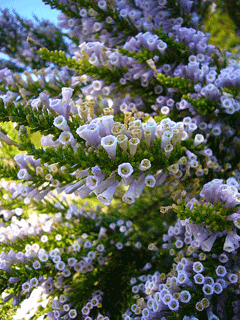
Pichi-pichi.
Pihca Conqui: A constellation named in the Huarochirí Manuscript and said to consist of a perfect ring of stars. AEAA
pinco-pinco: (n) Ephedra andina. Pinco-pinco is a shrubby plant which inhabits the South American Andes from Ecuador to South Chile and Argentina. The stems of most members of this genus contain the alkaloid ephedrine and are valuable in the treatment of asthma and many other complaints of the respiratory system. It is a bronchodilator. The whole plant can be used at much lower concentrations than the isolated constituents -- unlike using the isolated ephedrine, using the whole plant rarely gives rise to side-effects. Ephedra does not cure asthma but in many cases it is very effective in treating the symptoms and thus making life easier for the sufferer. Pinco-pinco's stems and tops are used as an anti-flatulent, anticongestive, for treatment for inflammation of the gums, and bladder infections, as an anti-tumoral, antibacterial, as well as a treatment for dysentery and as an antiseptic for wounds. It is also well-known as a depurative and diuretic. It reduces callus production. Ecuadorean peasants attribute amongst its benefits treatments for syphilis, mucous secretions, blood purifier and antirheumatic. AHC
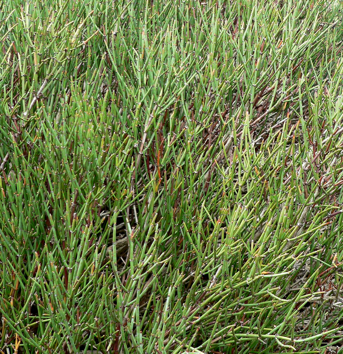
Pinco-pinco. WIKI
pisada (Span): (n) From pisar, to step on; to possess sexually or mount. SEES A maleficent act carried out against a victim by a huaca or by the encanto of a power place. GOL See, also, love magic.
pischaco: (n) Dis-spirited one who prays on the energy life force of others; the living dead. RS
pisco: (n) A traditional liquor used in ceremonies both divine and profane. It is a product of the European invaders who craved more familiar libations than chicha. A pure, highly potent, aromatic brandy distilled in Peru from a grape called the quebranta, pisco eventually became known by the port from which it was exported.
pita, ancaschampascera, maguey: (n) Agave americana. The Indians employ an infusion and decoction of the roots to cure rheumatic and venereal pains. It is drunk in large quantities. The leaves yield a honey or extract which is believed to be excellent for cleansing and healing ulcers. The leaves are roasted and the juice is squeezed out whilst they are still hot. The extract is then boiled down to the thickness of soft honey, in which state it is applied with no other agent to cure not only ulcers in man but also sores on beasts of burden and the wounds which they often suffer on the head and feet. REPC
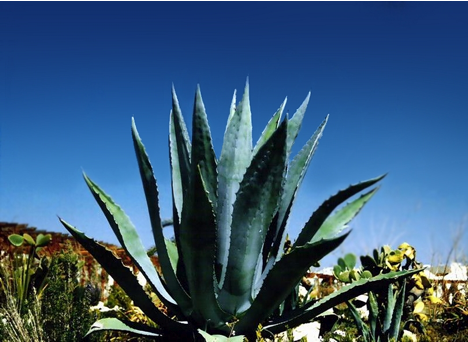
Pita, or Agave americana.
pitay: (v) To smoke tobacco. QP
Pitu Siray and Sawa Siray: (n) The names of twin peaks, are counted as one of the sacred mountains of the Incaempire. Their mystical significance is duality, yanantin/masintin (dissimilar/similar), hapu ranti (right relationship). JLH(See, Apu.)

The valley of Pitu Siray near Cusco.
Pizarro, Francisco: ca.1476–1541, Spanish conquistador, conqueror of Peru. Born in Trujillo, he was an illegitimate son of a Spanish gentleman and as a child was an illiterate swineherd. Pizzaro accompanied Ojeda to Colombia in 1510 and was with Balboa when he discovered the Pacific. Hearing of the fabled wealth of the Incas, he formed (1524) a partnership with Diego de Almagro and Fernando de Luque (a priest who secured funds). The first expedition reached the San Juan River, part of the present boundary between Ecuador and Colombia. On the second (1526–28), Pizarro explored the swampy coast farther south while his pilot, Bartolomé Ruiz, crossed the equator and then returned to bring definite news of the southern realms. In 1528 his partners sent him to Spain to secure aid from Emperor Charles V; he achieved this and gained for himself most of the future profits. Sailing south, Pizarro landed at Tumbes (1532) and ascended the Andes to Cajamarca, where the Inca, Atahualpa, awaited him. Professing friendship, he enticed Atahualpa into the power of the Spanish, seized him, exacted a stupendous ransom (see, Rumiñahui), and then treacherously had him executed. The conquest of Peru was virtually completed by the capture of Cusco, which was later defended against Inca forces led by Manco Capac. Pizarro set about consolidating his conquest by founding new settlements, notably the present capital of Peru, Lima, and allotting land and Native Americans to his followers. IPC
placenta (Eng): (n) The placenta of royalty had a definitive importance. Chronicler Sarmiento de Gamboa states that Inca Yupanqui built a palace in which he placed a statue of gold representing his mother Mama Rawa Occlo; in the womb of the statue he placed the placenta from his own birth. “It was customary to save the placenta when a prince was born…” DYE
plant teachers: (n) Used by vegetalistas who believe that if they fulfill certain conditions of isolation and follow a prescribed diet, these plants are able to "teach" them how to diagnose and cure illnesses, how to perform other shamanic tasks, usually through magic melodies or icaros, and how to use medicinal plants. They either: (1) produce hallucinations if taken alone; (2) modify in some way the effects of the ayahuasca beverage; (3) produce dizziness; (4) possess strong emetic and/or cathartic properties; (5) bring on specially vivid dreams. Quite often a plant has all these characteristics, or some of them. All psychoactive plants are considered potential teachers. La purga mlsma te enseña (the purgative itself teaches you), referring to the ayahuasca beverage. By ingesting and following the diet for a plant the shaman is trying to participate in some of its qualities. Many of the plant teachers are very tall trees, that resist heavy rains, winds and inundations. The shaman will then be able to withstand the elements in the same way. Some of the plant teachers produce visions only when associated with ayahuasca. Others produce only una mareación ciega (a blind dizziness), in which you do not see anything. Other plants teach only during the dreams. The teaching of native languages by plants is quite a widespread belief. MSIN Andean man sees himself as one plant more in the countryside, fixed in the earth and dependent upon her. WOFW
[Vegetalista] Don Celso never had a shaman as his teacher. On one occasion
he made a very significant remark: "That is why some doctors believe that
the vegetalismo is stronger than a medicina de estudio (Western medicine),
because they learn by reading books. But we just take this liquid, keep
the diet, and then we learn." MSIN
he made a very significant remark: "That is why some doctors believe that
the vegetalismo is stronger than a medicina de estudio (Western medicine),
because they learn by reading books. But we just take this liquid, keep
the diet, and then we learn." MSIN
pocosca sonqoyok: (adj) Of mature judgment. DYE
Poma, de Ayala Felipe: See, bio in Appendix M.
pomaysancca: (n) Caiophora cirsiifolia. Women in rural areas take an infusion or decoction to induce menstruation. REPC
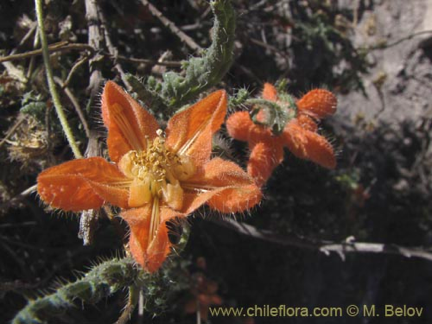
Pomaysancca
ponq'o: (n) Medicine circle; literally, a dark place in the water where trout gather. It takes the form of an energy exchange from the waynus of the individuals involved. In a group of three, the person at the head sends energy through her waynu, the person lying down transmits that energy, and the person at the feet receives it. The energy turns into luminous filaments, connecting in an oval bubble of light. MBE
poqen kanchay: (n) Where light germinates. TP
poques: (n) Innocent fool. DYE
poq'po, pukpu: (n) A bubble of living energy and, although not limited to, commonly refers to the electromagnetic energy field surrounding the human body. PSPM The living energy fields that are intimately tied into and connected with the human body. ANON1 The luminous body, the energy bubble or field around the body. KOAK See, kawsay poqp'o.
power: (See, cuenta, magnetismo, huaca, medicine.) The ancient shamanic concept of power: magnetism, a medium of telepathy and curing force; its concentration in the account of individual power objects (see, below), which in aggregate constitute a microcosmic mesa. Psychologically, power objects are also a projection of the shaman's personal power; the mesa is an extension of the shaman as receiver/transmitter (see, transistoriality). Characteristics of power: (1) Knowledge, especially ritual knowledge, and a correct perception of reality, omens and symbols. Knowledge is wisdom about the true nature of things. (2) Fate. Power can be sought, but seeking it does not guarantee that one will attain it. Fate, one's inner nature, determines whether or not one actually receives power. True power seeks out the shaman. (3) Individuality. Power comes only to individuals, and only to those who are worthy or ready. It does not manifest itself to groups, and it cannot be given by one shaman to another. (4) Variability. Everyone has some power, but its amount and intensity vary from person to person. It can increase or decrease through life. Shamans have more than the average individual, and there are different degrees among shamans. (5) Success. Without power a person is helpless. With it, one is successful, especially in curing or in practicing magic. (6) Focus. Although power permeates everything, it is focused in certain individuals (shamans), power objects (especially crystals, rattles, and wands or staffs), plants (especially hallucinogens), and natural locations (especially mountains and water holes). (7) Ambivalence. Power can be used for good or evil -- however, these may be defined by the shaman's society -- depending upon the innate disposition of the user. WOFW
Probably the central concept of shamanism is the idea of power. Simply stated, this is the notion that underlying all the visible forms in the world, animate and inanimate, there exists a vital essence from which they emerge and by which they are nurtured. Ultimately everything returns to this ineffable, mysterious, impersonal unknown. Its manifestation in the universe is described by modern physical science through such concepts as the mass/energy equation and the space/time continuum. But only the shaman and the mystic actually identify with power through direct personal experience. WOFW
power animal (Eng): (n) Power animals represent a person's connection to the animal's qualities of character and power. Power animals are common to shamanic practice in both Eurasia and the Americas. They are the helping or ministering spirits or familiars which empower individuals, lineages and nations. Most persons have power animals which empower and protect them from harm; the power animal may also lend the wisdom or attributes of its kind to those under its protection. WIKI
power object (Eng): (n) A sacred object imbued with unseen forces and energies which can be the catalyst for healing.PSPM Although power (see, above) permeates everything, it is focused, e.g., in power objects (especially crystals, rattles, and wands or staffs). Psychologically, power objects are also a projection of the shaman's personal power. WOFW
pregnancy (Eng): (n) Pregnancy was unwelcome in unmarried women. This was the real taboo and not sexual intercourse. If the prospective father married the girl, all was well; but if he was already married or he could not marry for social or economic reasons, severe punishments were inflicted on both parties -- even the penalty of death. Pregnancy was socially acceptable but not permitted to interfere with the working activities of the woman [who was] a very active member of the community until the time of delivery. She was considered with a certain magic awe and respect; and because of her evident capacity to accumulate in herself the fecundity of her surroundings, she was not permitted to come near the cultivated fields, lest she would steal away their fertility. Spanish chroniclers wrote how the women gave birth, delivering usually by the side of the road, after which they continued to walk home with their baby in arms. This was done unaided and in a matter-of-fact manner. As soon as the baby was born, it was bathed in cold water and tightly wrapped in diapers. Every day he was bathed again in cold water and, if the mother was specially affectionate, she took water into her mouth and sprayed all the baby's body with it, sparing the head, especially the soft part which was never touched. They said that in this way children became used to cold and hard work. DYE See, abortion, placenta (above), marriage, breech birth, twins, birth defects, umbilical cord, ayuscay and midwife.
premundos (Span): (n) Preworldly beings. JLH
priesthood (Eng): (n) Their powerful control over most important matters in the Inca realm must have created, at one time or another, a state within a state. It should be no surprise that the Inca saw to it that the appointment of the Willaq Umu was always under his personal control In fact, there are reasons to believe that the name Inca only became the title of the emperor after a showdown between the military and the priesthood during the early phases of the Inca dynasty. The title of military chief was Sinchi and, the title of Inca existed from the very beginning but was used only to denominate the civilian and religious authority. The second emperor, for example, was called Sinchi Roca, and there is evidence to assume that some major change in the balance of power took place before the sixth emperor adopted the name of Inca Roca. When Inca Wiracocha came to power he had to fight a ferocious battle to maintain his authority over Chinchisuyubecause the powerful priesthood provoked a subversive movement which almost destroyed the empire. His son, who became Pachacuti Inca (see, above), took command of the armies and succeeded in a victory, sending a multitude of priests to be punished. Thus he established his fame as Reformer of the World. He decreed that priests be chosen from the common people and were therefore subject to the common law and penalty of death. His successor, Tupac Inca Yupanqui, added a new rule which permitted women to be ordained as priestesses. However, the priesthood continued to be a sore spot in the empire. DYE See , Tarpuntaes
prisisaqpaq: (adj) Urgent. QP
profeta (Span): (n) Prophet; also, sut'inchaj. PSL
psychopomp (Greek): (n) From ψυχοπομπός -- psuchopompos, literally meaning the "guide of souls." A being whose role is to escort newly deceased souls to the afterlife. WIKI One who has the ability to achieve multidimensional journeyingfor the purpose of assisting a distressed or lost soul through its transition to another realm, most often to a more elevated dimension of consciousness or higher vibratory rate. PSPM See, chacaruna.
pucara, pukara: (n) Castle; tower; fort. RS A general Inca term for a stone house or fortification in the mountains. The Awka Runa had particular need of them. MAN

Puca Pucara (Red Fort) is located in the Archaeological Park of
Sacsayhuaman near Cusco.
Sacsayhuaman near Cusco.
Pucará: A pre-Conquest site and culture in the southern highlands of present-day Peru in the northern basin of Lake Titicaca. The site is known for its unusual horseshoe-shaped temple or sanctuary of stone masonry. Pucará-style stone sculptures and Pucará pottery show resemblances to those of Tiwanako, in the southern Titicaca basin. WBC Pucará flourished as a city-state from about 200 B.C. until about 200 A.D., and constituted a rival polity to Tiwanako. The relationship between these two cities appears to have ranged from intense competition to open hostility. Unlike their counterparts among some other cultures, the pastoralists (herders of animals) of Pucará apparently had no intention of accepting the emissaries of Wiracocha (the influence of Tiwanako). The source of conflict between Pucará and Tiwanako must have lain in the latter's commitment to fostering the spread of agricultural civilization in which pastoralism would necessarily play a secondary, supporting role, being told where and when to graze their animals. SIMA A line drawn on a map from Tiwanako to Cusco goes directly through Pucará, which is exactly equidistant along this line from Cusco and Tiwanako. This is the Road of Wiracocha. IGMP
Pucuy Sucanca: (n) Solar pillars in the Cusco area marking the December solstice, the beginning of the rainy season. AEAA (See, pucuypacha, sucanca.)
pucha (AYM): (n) Daughter. ASD
puchara: (n) Sacred place. CHAM
puka campachu, puca-campanilla, floripondio encarnado: (n) Datura sanguinea. The red angel's trumpet. a small tree with beautiful red flowers. DYE The leaves are used as emollients and anodynes either in the form of cataplasms or when simply applied single and entire. The seeds are narcotic, dulling the senses and understanding, and they are occasionally administered with evil intent as a powder in food. Some natives assert that there are those who have gone mad merely by lying down to sleep in the shade of these trees. REPC [Caveat: all daturas are very toxic, even deadly, when abused.] See, tonga, toé, chamico, brugmansia suaveolens.
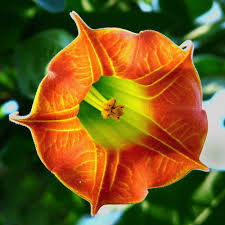
The flower of puka campachu.
puka chirapa: (n) The red rainbow, which is invisible and causes the illness pukaungo. AYV
puka-chukchas: (n) Literally, red haired. Men that travel in the rear of the Aceropunta. They look after the ropes so that no enemy will cause harm to those in the ship while they are performing their healing arts. AYV (See, picture at warmi murayas.)
puka-lupuna: (n) Also known as lupuna colorado (Cavanillesia hylogeiton). This tree's mama is very useful to sorcerers who do evil; her knowledge is almost always turned towards sorcery and rarely toward curanderos that heal and save lives. This tree also demands a rigorous diet or immediate death awaits. The tree connects the underwater world with outer space. In Shipibo cosmology the tree is usually hollow and contains fish, the water of its interior communicating with the waters of the subaquatic region. The original Shipibo souls rose through the hollow trunk to reach Heaven. The puka-lupuna is a great magician that developed in other dimensions and came to possess this tree. The kapukiri produced by this tree has the person feeling as if his/her head grows larger and feels a smarting all over. The illness is most often located in the stomach. If the patient is a pregnant woman, the newborn baby looks rachitic [as if it has rickets]. AYV (See,palero.)
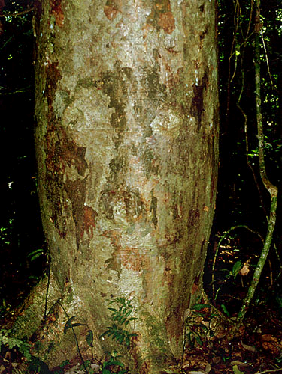
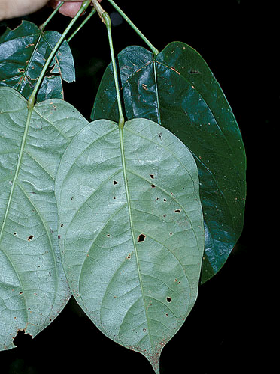
The trunk and leaves of a puka-lupuna.
puka-ninaruna: (n) Literally, people of the red flame. This type of yakuruna lives in the largest of the underwater citiesand is invoked by the murayas as an ally to control the anguila mama, sea monsters, thunder and storms. AYV
puka-purahua (Amaz): (n) A great water snake that shoots magnetic rays from her eyes by which she is able to attract anything coming from above. She can transform herself into boats of various shapes. AYV
puka-urcutucu: (n) The red owl, seen in the image at sacramachaco, has eyes of fire and guards the shamans while they are curing. AYV
Pukina: (n) An ancient [extinct] language of the Tiwanako State – mother tongue of Aymara – was the most prestigious language spoken by the elite of governors. WAO2 The secret language of the Inca which they used to discuss the mysteries of the healing arts. IMAX See, Qhapaq Simi. [Although there are claims on the internet made by various tour companies that several groups in the Lake Titicaca and Altiplano area still speak Pukina, linguists count Pukina among the dead languages of the world. -- Patt]
puklla: (n) Game (a form of sacred entertainment). ANON1 See, pukllay, below.
pukllay: (v) To play (a game). (n) (1) A game, sports match. QP (2) The uncanny ability to go to places of innocence and play. There, the synapses are so alive. AVO The playing out of a ritual. QNO
pukllay kawsay: (n) The game of life. PSPM
pukuchu: (n) A bag made from the fur of an alpaca born dead, aborted or dies immediately after birth. ROR A little bag marked with yarn tassels made of the skin of an unborn (aborted) llama which holds coca leaves. This bag is used by women in the Andes in soul retrieval ceremonies to hold the retrieved soul part until it can be returned to the individual. JLH
puma: (n) A lion (Puma concolor), also mountain lion, cougar, or panther, is a mammal of the Felidae family, native to the Americas. This large, solitary cat has the greatest range of any wild terrestrial mammal in the Western Hemisphere, extending from Yukon in Canada to the southern Andes of South America. An adaptable, generalist species, the puma is found in every major New World habitat type. It is the second heaviest cat in the New World, after the jaguar, and the fourth heaviest in the world, after the tiger, lion, and jaguar, although it is most closely related to smaller felines. A capable stalk-and-ambush predator, the puma pursues a wide variety of prey. It prefers habitats with dense underbrush for stalking, but it can live in open areas. The puma is territorial and persists at low population densities. Individual territory sizes depend on terrain, vegetation, and abundance of prey. While it is a large predator, it is not always the dominant species in its range. It is a reclusive cat and usually avoids people. With its vast range, the cougar has dozens of names and various references in the mythology of the indigenous peoples of the Americas and in contemporary culture. WIKI (2) An archetype of the Kaypacha. (See, Puma Runa.) IGMP The puma is sometimes interchanged in this mythology with the jaguar, although the two species have different habitat preferences. For example, Cusco is sometimes called the Jaguar City, although a section of the city is named the Pumap Chupan, or Tail of the Puma. (See, Appendix D for map.) Some teachers of Inca shamanism use the jaguar as the archetype of the Kaypacha. PGO The master of the kaypacha who can survive from the coastal deserts to the highest mountains; a symbol of the impeccable use of the mind as an enlightened, sun-oriented principle; a symbol of right action, the perfect physical body aligned to use in the kaypacha. ANON1
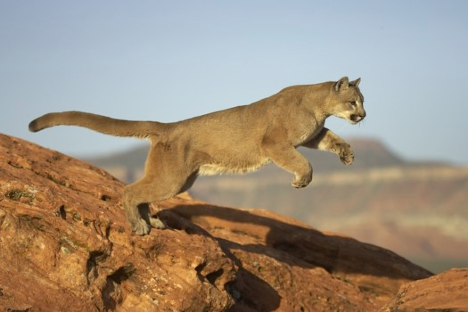
The puma, or mountain lion, is an archetype for the Kaypacha.
puma chucu, pumacuchu, ratanhia, mapato: (n) Krameria triandra. Commonly known as rhatany, ratany or rattany. Rhatany is also the name given to krameria root, a botanical remedy consisting of the dried root of para rhatany (Krameria argentea) or Peruvian rhatany (Krameria lappacea). The biological action of rhatany is caused by the astringent rhataniatannic acid, which is similar to tannic acid. Infusions have been used as a gargle, a lozenge, especially when mixed with cocaine, as a local hemostatic and remedy for diarrhea. When finely powdered, the dried roots furnished a frequent constituent of tooth powders. The powdered roots have also served to color wines ruby red. The root bark contains an almost insoluble free red substance called ratanhia red. WIKI Rhatany is a plant that is fairly uncommon. The root is used as medicine. Related plants (other Krameria species) are sometimes secretly added to rhatany preparations to expand the amount of product provided. People take rhatany for intestinal swelling (enteritis) and chest pain (angina). Rhatany is sometimes used as a mouthwash or gargle for mild mouth and throat irritation, swollen gums, cracked tongue, and canker sores. It is also applied to the skin for leg ulcers and for swelling and itchiness caused by cold and damp weather (chillblains). WEBMD The roots have excellent styptic properties that can staunch the flow of blood, according to native belief. The dose for a decoction is half an ounce of dry root or one drachma [dram] of its water extract weakened with two or three ounces of ordinary water. This root is good for cleansing and strengthening the teeth. It surpasses in efficiency all other herbs which are employed at the present time to staunch the flow of blood and lacks the evil after-effects that other astringents cause. Experiments with more than one thousand persons who have taken the extract under the care of the best physicians bear out the statement. REPC
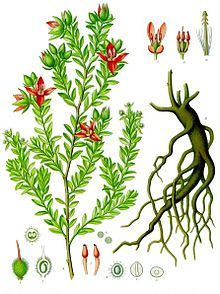
Puma chucu leaves, flowers, root, seeds. WIKI
Puma Runa: (n) (1) A shaman dedicated to ceremonies associated with the puma. The puma is shy but fearless, fleet and fast, secretive, and as animals of the night, hard to see. According to Andean belief, a shaman has similar characteristics. ACAI (See, Awakening the Puma. (2) There are a lot of these Puma People coming to Earth at this time, coming with the new Pachacuti. The puma is a warrior. The puma has balance. The puma has purpose. The Puma Runa have these same qualities in their spiritual quest as they experience all the worlds and their realities. A potential puma lives in every person. The puma walks alone, so part of our spiritual journey is alone. Only you can bring the heavy energies from inside of you. The great teaching of the puma is that it is the animal with the least ego, never seeking to be seen. You don't see the puma, only where it has been. IGMP (See, luminous warrior.)
pumas-sirenas: (n) Mythical creatures with the body and a hair of a woman but the face of a tiger, with very hypnotic tails. They are used by the murayas to catch the bufeos colorados who sometimes rob women and make them pregnant. With the help of the puma-sirenas, the murayas are able to rescue these women and release them from their pregnancy (sp). AYV
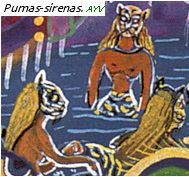
puna: (n) Lofty region; elevated, cold plain. RS Usually above 12,000 feet, treeless and covered in grass. CSCR Land over 3,900 meters above sea level. RDP (See, quechua, suni)
Punchao, Punchau, p'unchaw: (n) (1) Young androgynous child (4 or 5 yrs. old) that is an archetype of God, the Light of Lights. JLH (2) Another name for the Inca sun god. He was usually depicted as a warrior armed with darts. WMO (3) The principal image of the Qoricancha. Meaning day, image of the sun or image of the dawn, a cast gold man-sized effigy described by Viceroy Toledo as having "a heart of dough in a golden chalice inside the body of the idol, this dough being of a powder made from the hearts of dead Incas." This most important image of Inti was captured with Tupac Amaru [in Vilcabamba in 1572] and probably melted for its gold by Viceroy Toledo. COI There is an account that it exists in the royal collections of Spain. WME The statue was kept in a shed located in front of that square [in front of the Qoricancha] which was used to venerate Punchao (a representation of the Sun that consisted of a pure-gold statue that was as high as a ten-year old child). It remained there during the day and in the night was taken to the square to be worshiped; the idol "slept" accompanied by many ñust'as in a close shed, outside the ground, and then it was returned to its original place in the morning. CPO (4) Day. RS (See, Epunamun, mallqui.)
punkisqa: (adj) Swollen. PSL
punkiy: (v) To swell. PSL
punku: (n) Gate, door; mountain pass. ANON1
Puno: A city near Lake Titicaca. According to legend, Manco Capac, the first Inca, rose from the Lake and traveled by what is now Puno on his way to Cusco. Later, he returned to the Lake and stopped to rest in Puno. (See, puñuy.) IGMP
Punpuri: (n) Village north of PotosÍ where believers crawl around the cemetery at midnight hoping to be healed by the local saint. PSL
puñuchacuni: (n) The irresistible tendency to fall asleep. DYE
puñuchiy: (v) To put to sleep. PSL
puñuna: (n) Bed. PSL
puñuskiri: (adj) Eternally deadened. RS
puñuypayani: (n) Extremely prolonged sleep. DYE
puñuy atiy, puñuy atiwan: (v) To be sleepy. PSL
puñuy aysay: (adj) Sleepy. QP
puñuysapa: (adj) Sleepy, drowsy. PSL
Puquín Cancha: A temple of the sun on the hill of Puquín where a portion of the Qhapaq Raymi celebrations took place. AEAA
puqyu, pukio, pujyu, pukyu, pukyo, pucyu: (n) (1) Well of light, like a chakra or energy center. JLH (2) A spring. Well or fountain. PSL Source, natural spring, well. RS
purampsii, China root: (n) Smilax China. An infusion of the roots is frequently used by the Indians to relieve rheumatic pains and as an excellent sudorific [causes sweating]. REPC The rhizome of purampsii can be used in the form of powder or paste, cooked or raw. The daily intake of the rhizome should not exceed 10 grams a day, as heavy dosage may result in nausea and vomiting. Pregnant and lactating women should avoid purampsii formulations as it may affect their health. It is used for white discharge or leukorrhea in women. It has been found to be quite effective in controlling the problem. Purampsii contains several medicinal properties including control of swellings (anti-inflammatory), removal of pus from wounds, promotion of urine (diuretic), bringing down high body temperature, removing gas (flatulence) and clearing bowels. The most important medicinal properties of purampsii however, are its ability to fight psoriasis, syphilis and leprosy. It is a preferred herbal treatment for psoriasis. Purampsii powder is also prescribed as a general health tonic. It is bitter in taste. A little quantity of powder can be taken after meals to tone up the body system and purify the blood. Available in herbal stores,it can be used for skin ailments like psoriasis, leprosy and venereal diseases like syphilis. There are formulations which serve as aphrodisiac, besides improving the sperm count. IHC
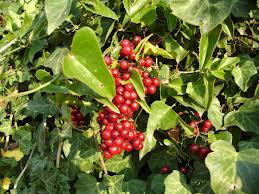
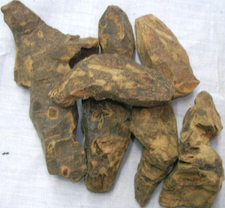
Purampsii leaves and berries. Purampsii rhizomes.
puru: (n) A drinking vessel made from a tropical gourd used in ritual. ROR
purun llaqta: (n) Ruins. QP
purunmachus: (n) Literally, wild old men. RS Sarcophagi located at Carajía (see, for picture and more context). WOTC
puruña: (n) An earthen jar used in rituals to hold water. ROR
Purun Runa: (n) The people of the Third Sun. Literally, the wild people. Despite their name, civilization was increasing in complexity: people had learned to spin, dye and weave llama wool; they practiced more sophisticated agriculture, they mined and worked metals. The population of the world increased, and people found it necessary to migrate from the Andes into the lowlands. They lived in towns, each with its own king, and there was conflict between towns and regions. The people generally called their creator Pachacamac in this era. MAN (See, pachacuti.)
pururaucas: (n) Stones miraculously turned into warriors during the seige of Cusco. Pachacuti Inca Yupanqui called upon divine help in the war against the Chancas, whereupon the stones in the field rose up as armed men to fight beside the Inca. After the battle, Pachacuti ordered the stones gathered up and distributed among the city's shrines. The stones became huacas. MAN
pusanga (Amaz): (n) Spell, witchcraft; a talisman charged to dominate or attract sexually. THIM AYV Love magic ritual of the Peruvian Amazon that causes one (either male or female) to fall madly in love with the other person (for sex, love or marriage purposes). In Peru this practice is very common, and is widely and accepted by all parts of society, without the negative associations in Western culture. EMM
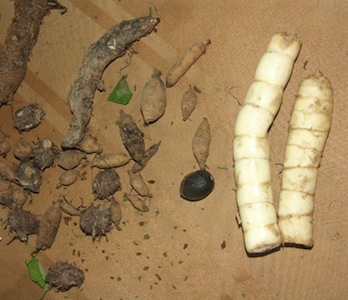
Pusanga herbs.
pusaq: (n) A guide (person). QP
pusnu: (n) A lowered, recessed, or concave ceremonial space such as a sunken plaza in a temple or a low open space for rituals and offerings; for example, the main plaza at Chavin de Huantar; the yanantin of the usnu forming half of the Andean cross (chacana). ANON1
putu: (n) Skull. Often seen on a healer's altar as a healing tool. ANON1
Putukusi: The name of the female mountain just at the entrance to the ruins of Machu Picchu. Her name means Flowering Joy. QNO : Always flowering or always happy mountain. IGMP
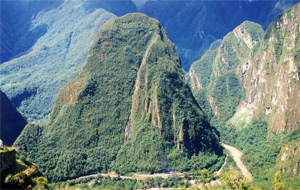
Putukusi.
pututu, putu: (n) Sea shell or cow horn trumpet. PSL Conch shell horn used in ritual for the transmuting and dispersal of hucha and calling out to spirit allies. ANON1 See, ch'aski and strombus conch shell.
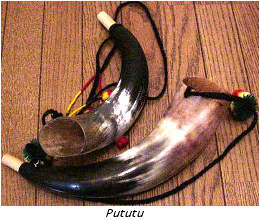
puya, cardón: (n) Puya chilensis. A terrestrial bromeliad originating from the arid hillsides of Chile. An evergreen perennial, it forms large, dense rosettes of grey-green, strap-like leaves edged with hooked spines. The green or yellow flowers are borne on spikes which resemble a medieval mace, and stand up to 2m high. Spreading by offsets, Puya chilensis can colonise large areas over time. Growth is slow and plants may take twenty years or more to flower. The outer two thirds of the leaf blade bears outward pointing spines which may be an adaptation to prevent herbivores from reaching the center of the plant. The plant is believed to be hazardous to sheep and birds which may become entangled in the spines of the leaves. It has been suggested that if the animal dies the plant may gain nutrients as the animal decomposes nearby. Fibers from the leaves are used to weave durable fishing-nets. WIKI An excellent extract for setting fractures is gotten from the long stalk of the inflorescence of this plant. The nectar of the flowers is fragrant and tasty; when applied to an aching ear, it is said to lessen the pain and to cure the ailment. REPC
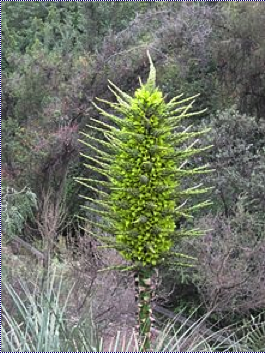
Puya. WIKI
puyhuan sonqoyok: (n) Literally, man with a beastly heart. A man whose intellectual capacity was clearly deficient. DYESee, sonqo.
